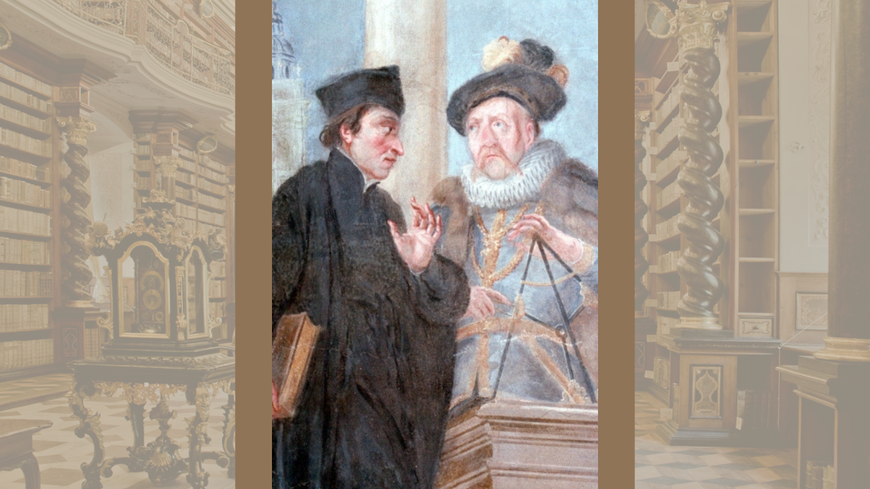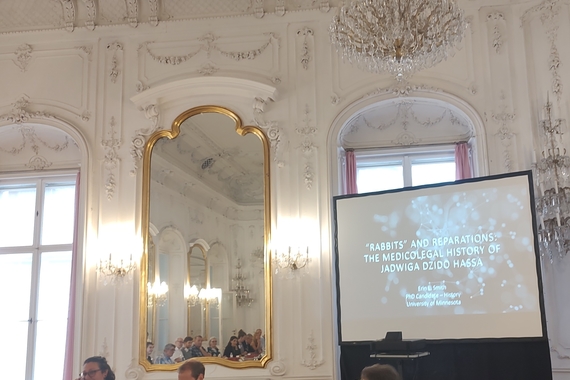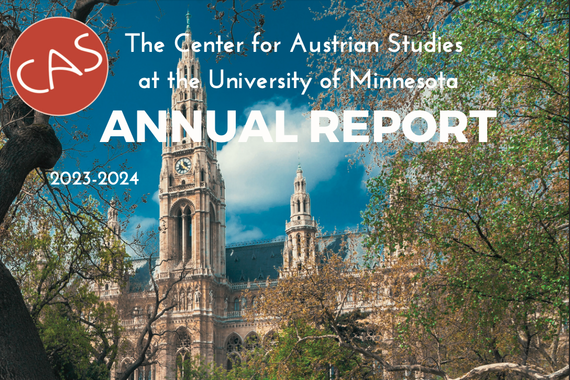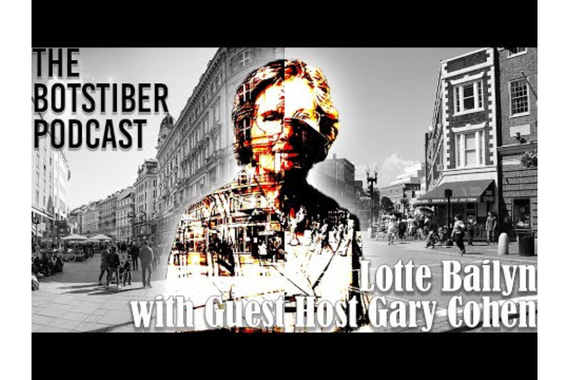Interview With Professor Jole Shackelford on Franz Halberg and the History of Chronobiology
Jole Shackelford, Professor of History of Science, Technology, and Medicine, is currently conducting research on the Austrian chronobiologist, Franz Halberg and the history of the field itself. In this interview, Shackelford shares his story of how he became drawn to the subject, his research processes, and what he has discovered. It is important to note that much of the research on the field of chronobiology, “the branch of biology concerned with natural physiological rhythms and other cyclical phenomena (Oxford Languages, 2023),” centers around its main founder, Franz Halberg, who has a complex legacy. Shackelford discusses. Shackelford provides information on Halberg’s European past, which includes discussions on his activities during the Second World War, the complexities of his Austrian identity, and his immigration to the United States.
CM: How did you become interested in studying chronobiology?
JS: I first heard of the term in 2008 when I received a phone call from someone wanting to use a photo that he found on my faculty website. It was a photo of two astronomers speaking to each other and was part of a ceiling mural in what had been the former Jesuit seminary in Prague, the Klementinum. Today, it's the National Library of the Czech Republic. The ceiling mural is in the math library and shows the Italian astronomer, Riccioli, talking to a Danish astronomer, Tycho Brahe. This person who was calling was looking for a picture of Riccioli, because he was working on a paper on sunspots, and Riccioli was one of the first people to describe sunspots. I told him that he was welcome to use it, but at the end of the conversation, he said somebody should look into the history of chronobiology. And I said, “What's chronobiology?” He said, “Well if you are interested, you'll find out.” The person on the phone was Franz Halberg, and he was sitting in the Old Mayo Building which is about 500 yards from where we are doing this interview now [Diehl Hall]. But I had never heard of him and I'd never heard of chronobiology.
CM: Wow. So how did you begin researching this topic?
JS: During that quiet time between the end of that semester and giving final exams, I sat down, and started looking online for information about chronobiology, trying to understand what it was. I searched our History of Science collective database, and it came up with just one paper that had been written on the subject.
CM: Just one?
JS: Yes, one that used that term, “chronobiology.” So, I went and read that paper and the paper was concerned with Halberg and his naming of the field "chronobiology." The paper was written by a historian and a sociologist of science from McGill, who focused on disciplinarity, i.e., defining when a field becomes a standalone discipline. Often there are certain identifying characteristics. For example: degrees granted in the fields, specialized journals, specialized conferences, etc., and those authors had decided that chronobiology had not reached the level of a discipline. But in the process, they mentioned Halberg taking over a scholarly society and using it as a basis to try to define the field as a new science.
With the history of the discipline aside, my immediate thought was “Here is an entire branch of science that historians of science have not worked on, this would be wonderful for a graduate student to pick up and use as the basis of a career.” So, I put together a short slideshow of highlights on the history of chronobiology for some of my fellow faculty members and graduate students who might be interested in the topic, but unfortunately, the graduate student who was at a stage where he might have chosen this as a topic had already chosen to work on the history of cloning, so nobody was interested. I left the project untouched, as I turned my attention to the spring semester.
But then, our faculty later had a joint History of Science, Technology, and Medicine meeting. One of the subjects of the meeting was identifying potential topics for an NSF grant. So, I said, “What about the history of chronobiology?” I was tasked to come up with a proposal for the next meeting and eventually, two of my colleagues joined me for the two-year grant project which aimed to hire a postdoc, have a seminar on the subject, and host a small conference here at the University of Minnesota, which we did in May of 2012. When we had this small conference, since there were no historians of chronobiology, I invited some scientists, a philosopher, a fellow who did a book on the history of sleep studies, and several historians working on related subjects. A few people also came from the biological side. During the conference, one of the biologists took me aside and said, “We almost didn't come to this conference because Minneapolis is where Halberg lives, and we don't speak anymore.” What struck me then was the reality of the field; Halberg had a group of people who thought he was great and also had a whole group of scientists that did not like him at all. At any rate, this was why I became intrigued by chronobiology and Franz Halberg. There were so many tensions in the field.
CM: I had no idea there was such a contested history.
JS: Yeah, and it still is contested! I’ll begin by mentioning the International Society for the Study of Biological Rhythm, founded in 1937. I call it the ISSBR for short. The ISSBR met every other year from 1937 up to 1971, and in the late 1960s, Franz Halberg was elected to be the President of the Society. At its first meeting in the United States in 1971 in Little Rock, AR, Halberg proposed a name change from the International Society for the Study of Biological Rhythms to the International Society for Chronobiology. Essentially, he was branding it with his term, “chronobiology.” Interestingly, the journal published by the ISSBR traditionally had a red cover, but when biologists eventually rebelled against Halberg’s leadership and broke off, they published a separate journal with a blue cover. There is quite a rift there that continues into the work of graduate students. Students of the blue cover wouldn’t go to the red cover’s labs and vice versa. It was a bifurcated world and there were a lot of reasons behind it, partly methodological, partly ideological, and in the case of Halberg, part of it was personality, and I became fascinated with this personality.
CM: Can you say more about Halberg’s life?
JS: Halberg himself was a mystery. When I first met him, he was pretty old. He was born in 1919 and I met him in 2010. He lived until 2013, by which time I was actively working on this. I actually tried to do an oral history with him, and it failed. I came with two pages of single-spaced questions to ask him and, being a historian, I was thinking of this as a biographical interview. My first questions were about his childhood, early education, and things like that, but when I asked, he said, “I don't talk about that.” So, after a few uncomfortable minutes of trying, I just abandoned my questions and started asking him about his work, his life, his field, his marriage, and things that he wanted to talk about. But his unwillingness raised my curiosity.
CM: Before we come back to Halberg, let’s discuss this project in greater detail. How does this project on chronobiology depart from your earlier projects or is it related in any surprising or unsurprising ways for you?
JS: My training was in early modern European science and medicine, and I was focused on the Middle Ages into the Reformation period and the Scientific Revolution, so 1450 to 1750 approximately. My doctoral dissertation was on a late 16th-century Danish physician, Petrus Severinus, who was an adherent of Paracelsianism, a particular school of medical, philosophical, and religious thought associated with the German medical reformer, Paracelsus. However, chronobiology is mostly a 19th and 20th-century topic. I had no formal training to prepare me for this, so it was a lot of retraining.
In fact, I asked a former senior colleague, who had been a historian of biology here at the University of Minnesota, whether it made any sense for me to follow this new interest and he said, “Not really, you should stick with what you are specialized in,” but I thought at some point, you have to follow your heart. Luckily, I did have broad training in the history of science. My undergraduate academic career started as a student of engineering, and I hold three degrees in the history of science, so all those combined gave me the confidence I really needed to retrain in modern biological history and chronobiology.
CM: How do you see this project relating to Austrian studies or Central Europe in general?
JS: Well, it didn’t so much when I started out, but Franz Halberg always identified himself as an Austrian from the first time anybody at the University of Minnesota knew of him, and I have this on the basis of archival evidence. He was brought to the University of Minnesota by the then-chair of the Physiology Department, a fellow named Maurice Visscher. Maurice Visscher was one of these larger-than-life people, he was a card-carrying Unitarian active in the Unitarian Church, both locally and internally. He was a signer of the Humanitarian Manifesto and the Unitarian Manifesto of Principles, so he was a pacifist and a very powerful local leader, and he had met Halberg in Europe in 1947 at the University of Innsbruck. A few years later, when Halberg was looking for a place to land in the United States, Visscher brought him to the University of Minnesota and found some temporary money until Halberg could become established and join the faculty. Halberg would probably not have stayed in the United States or become a chronobiologist if it had not been for Visscher's patronage.
Halberg always said he was an Austrian, both to other Austrians and also to the Americans. In fact, on the passenger manifesto of the boat he came over here on in 1948, he was identified as an Austrian and when the United States Army sought to send him back to Austria when his fellowship ended, they had money to send him back to Innsbruck. Halberg was born after the fall of the Habsburg Empire in northern Transylvania, and he got his MD in 1943 in Cluj, the provincial capital of Transylvania. In a lot of his writings, he explains that he grew up in Transylvania, that his father was an international lawyer, that he'd done research at a Rockefeller Institute in Budapest in the 1940s, and that he had been hired as an assistant at Innsbruck after the war. But, Halberg never said anything about the war. In fact, in 1943 when he got his MD, the War was not only still on, but Romania was an active ally of the Third Reich and they were fighting side by side. And so, the obvious question that I wanted to ask Franz Halberg was, “How does somebody graduating in 1943 with an MD who is young and able-bodied escape being put in the army?” I never found out from him, but I always wondered what he was doing during World War II.
CM: That's very mysterious.
JS: Yeah, it is. Unfortunately, I didn't know anything about the history of Transylvania at the time of the interview with Halberg. Had I known something about Transylvania and its history, it would have helped me understand his story more. These questions that I had ultimately took me into the world of the Austro-Hungarian empire. Transylvania had been part of Austria-Hungary in the 19th century, but at the end of World War I Transylvania was given to Romania. However, when Halberg was born in 1919, although technically part of Romania, Transylvania’s transfer to Romania had not been ratified, so he (like many others) could have claimed that he was born in Austria.
CM: It is significant that he chose to maintain that specific identity.
JS: Yes; in August of 1940, as a result of the Vienna Diktat (a meeting that Hitler mediated), the Nazis recommended giving Northern Transylvania back to its ally, Hungary, to make up for Hungary’s territorial losses following World War I. From 1940 to 1945, Northern Transylvania was Hungarian. And so, as many people did at the end of the War, Halberg questioned: Was he Romanian? Was he Hungarian? Was he Austrian? He had never been Hungarian, at least legally and he didn’t have any papers, so he latched onto an Austrian identity as something that would help him get into the United States or Britain. And which would shield him from questions about his past. At any rate, I think of him as having an Austrian background. Also, when he got to the United States, he met a young woman and she was from Innsbruck, and they ended up getting married, so there are multiple other Austrians in the woodpile, as it were, for this project.
CM: This project resulted in a three-volume book series on Chronobiology. Is that correct?
JS: Yes, that’s right.
CM: How did you go about conducting research for your project? And, how was it archival in nature?
JS: I wanted to work on the Halberg project, and I wanted to work on the search for the biological clock as part of that. Those were the driving parts for me, but it was clear that I needed to know the background, and there was no background. The first step was to try to define the scope of the field. I started reading widely in all time periods on anything that would help me understand what chronobiology and biological rhythms research was all about. That’s when I realized I had to do an introduction to the history of chronobiology as the basis for my later work on Halberg, which is what I'm working on now. I really enjoy doing archival work. It's original. For one thing, being closer to the sources avoids some of the filters that later interpreters put on things, but archival work is also very sporadic.
In 2012, I was invited to a small conference that Halberg’s daughters had organized, and I asked them “Does your father have any papers, any records?” They didn't know of any. I also asked them about their grandparents and if they knew anything about their family. They said, “No, our grandparents all died before we were born." So, there were no Halberg archives per se. Most of my work has been based on printed materials. I looked for other archival materials. There was a chronobiologist at the UMN in the 1960s, but he had left Minnesota to found the Department of Organismal Biology at the University of California-Irvine when it was a new campus. I thought there would be some archival papers there, but, unfortunately, they were all from after he had moved to California, by which point he had quit working on chronobiology, so it was of little use except for a couple of interesting quotations. I did find extensive papers by Frank Whitney Finger, an experimental psychologist at the University of Virginia. One of his graduate students was interested in chronobiology and got Finger interested in it. He was in contact with Halberg and was taken under his wing, so his papers became a very good insight into Halberg's hegemonic process of trying to take over the field and define it as he saw fit. But I have not found the wealth of material I would like, so it's been a bit of a challenge.
JS: I also looked into a useful collection at the Harvard Theological Archives, which contains a digitized set of documents surrounding Unitarian committee work. One of the Unitarian medical missions, which Maurice Visscher chaired, was to Austria in 1947. Basically, the papers contained answers to questions asked of each of the members of the mission: what had happened, who they had talked to, and what they thought of people. One of the missions' agendas was to think about people to bring over to the United States for further medical training to send back to Austria. Halberg was one of these people. However, he didn't go back to Austria.
CM: So, with the unknowns regarding Halberg’s past, and the lack of archival sources, how has that affected your research? Has it made it more challenging? Have you come across anything surprising when you've had to navigate this challenge?
JS: For me, it was a mystery to be solved and it's been piecemeal work. Because it's a new field in the history of science, it's all discovery at some level and some of it is obvious in hindsight, but if you haven't discovered it, you won’t know about it.
JS: For example, Halberg basically made this claim that physiology traditionally was more than a three-dimensional affair. Biology is fundamentally morphological (i.e., it pertains to the form and structure of things), and this was especially true in the 19th century. But Halberg argued that time is a 4th dimension here, and that's what chronobiology is about. It's about the temporal dimensions of biological organisms. Halberg took possession of the term and ran with it. His earlier work focused a lot on the idea of the physiological week. The 7-day week for us is an artificial construction, so Halberg focused on studying that. Eventually, Halberg did demonstrate a 7-day chronobiological week, which is quite interesting. Halberg's later work was on much longer rhythms based on sunspot cycles and other solar radiation cycles. However, this is where science got difficult though because of small sampling sizes, so a lot of other biologists were skeptical about it. For my research though, this initial 4th-dimension aspect was novel to think about. How do the different organisms and systems in the body interact in time? Or, oppositely, fail to interact in time if you get imbalanced due to, for example, a transatlantic flight?
During the 1960s, more scientists were interested in finding the clock rather than studying its effects. Halberg called them clock watchers. I read an account where one of these so-called clock watchers wrote that circadian rhythm was the first genetically coded rhythm behavior to be determined. I thought back upon that statement and was reminded of Darwin. During Darwin’s time, it wasn't morphological evolution that was a problem for people understanding evolution. Nobody really cared whether people looked like apes or not, but they did care about behavior. They did not want behavior to be genetically coded, because that runs into problems with free will, religion, and ethics.
CM: This is a good transition into my last question. In your opinion, why do you think the history and progress of chronobiology are vital to the history of science?
JS: Well, the uninteresting answer, I suppose, is that it's a field of science that hasn't been explored. Chronobiology is a field that nobody's done the history of, so it needs to be there for completeness. It's also important for me because doing this research is looking at something that's not been worked over. Take the scientific revolution for example, it has a canonical history that has taken form. There is a framework. If you want to study the scientific revolution, you have to start with the books that have been written about it, but then you can take that framework that's already been built and either further it or dismantle parts of it, but with the history of chronobiology there was no framework. I now get to play the role of laying out the map. Then, hopefully, if this trilogy is successful, people will come along and say “No, Shackelford got this wrong," and they'll do some reinterpretation and rebuild the map, but at least I've provided the rudimentary sketches.
There are some more modern reasons that I think the history of chronobiology is important too. For example, in the 1960s Halberg and some of his colleagues did very good clinical work, showing that if you take rats and give them poison at different times of day it has different effects. So, even toxicity is a circadian rhythm. This led to some advancements in chemotherapy that are now under a field called chronopharmacology. It is quite difficult to pin down how this works, because people are so variable in their habits, unlike rats, but it has the potential to produce good medicine or biology. A fellow actually did a survey about twenty years ago, calling up several directors of hospitals and presidents of HMOs, asking them if they knew about chronobiology, if they practice any chronobiology, and if it is included in medical school curricula. It isn’t used much and why it hasn't had an impact is something that I haven't quite understood yet.
This research is personal to me. It took over my life, and really, for the last 14 years, it's mostly what I've thought and written about, so it's quite special.
CM: Amazing. Well, thank you so much for your time. Those are all the questions I had for you today. This was very interesting to hear about your work.
This interview took place in person in Diehl Hall at the University of Minnesota- Twin Cities on April 3rd, 2023. It was conducted by Claire Mavis who, a 2023 graduate from the UMN Department of History and former staff member of the Center for Austrian Studies.



